One of my summer projects is to make up color cards for different embroidery thread sets that I have – or sort of have – or want to have…..
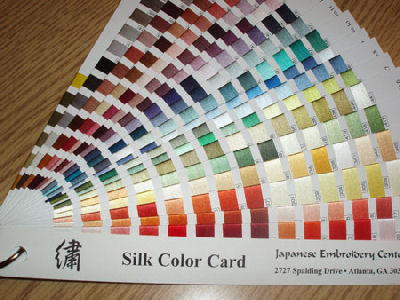
Making up color cards is one of the many ways I’m working towards Complete Organization! But it takes time.
Now, there are different ways to “see” the colors of different lines of needlework threads, but in fact, without actually seeing the threads in person, it’s hard to determine exact colors.
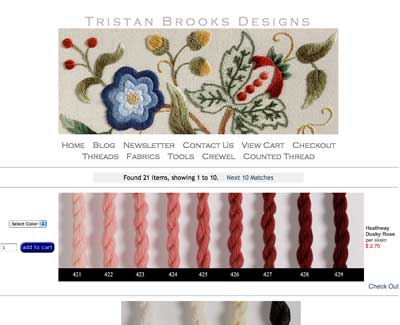
Still, I like to visit (and shop at) online stores that show the threads they carry in their various color families. For example, at Tristan Brooks Designs, you’ll find that all their Heathway wool is photographed so that you can see the varying shades of the different color families of that line of thread. The photos are of full skeins – and you know it had to take a lot of work for them to photograph all these threads and get them on their website for display! As a consumer, I appreciate that work. I like to see the threads, even if only virtually.
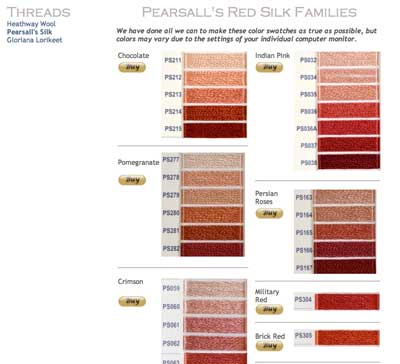
Tristan Brooks Designs also does the same thing with their Pearsall’s silk. The pictures here are of real thread color cards – that is, cards wound with actual thread, and lined up according to shade and color family.
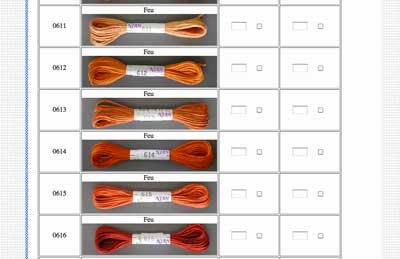
Needle in a Haystack also does this, with practically their whole range of threads. They’ve got, for example, all the Soie d’Alger by Au Ver a Soie on there, with individual photos of each color, arranged in numerical order, which makes it very easy to order thread from them, if you happen to know the color number you want.
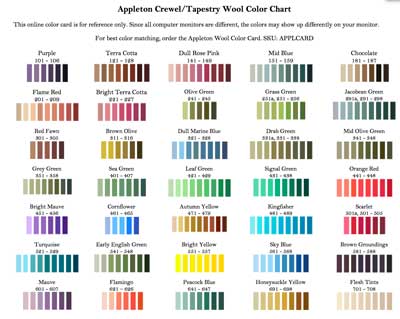
You can also find, online, charts of the shades of threads, that aren’t actually photos of threads. For example, Discount Needlework offers a PDF of Appleton Colors like the one above.
Of all the methods of displaying thread colors online, I prefer photographs of the actual thread. Images of printed documents with color blocks that represent shades of thread are not as accurate – and in fact, they are twice-removed from accurate. First, a printed color card itself isn’t very accurate, and second, an image of a printed color chart seen on a computer monitor is even less accurate. But what it boils down to, really, is the fact that photos of threads aren’t super-accurate either (they’re better than nothing, though, and much better than images of documents with color blocks on them). The inaccuracies of thread colors seen online stem from two points: 1. All computer screens display color differently, depending on the settings of the computer screen. There’s some fancy equipment out there that can help avoid inaccurate color (especially for people who do a lot of print design), but for the average computer user, when we see color on our screens, what we see isn’t normally what we get. 2. Even in photographing actual skeins of threads, when the image is captured, there’s no guarantee that the thread color was captured accurately – lighting situations and camera settings (or scanner settings) influence the color in the captured image.
When it comes to actual color cards, then, that you can have on hand for reference, they are of two kinds: the printed color card (with blocks of color representing the color of thread printed on sheets of paper or cardstock) or real thread color cards, with actual samples of the real thread assembled on cards so that you can see the actual thread color.

I have two real-thread color cards – the one above, of the range of Japanese flat silk from the Japanese Embroidery Center, and a book of real thread color cards of the line of Au Ver a Soie threads, put out by Access Commodities years ago (and no longer produced).
Other lines of thread do have their own real-thread color cards. Appleton, for example, has a nice fluffy one full of all the crewel embroidery threads offered by Appleton. Here in the States, you can purchase the Appleton real-thread color card through Wooly Thread.
Being able to walk into a local needlework shop (located preferably right next door to your house!) that carries every kind of thread you could ever want, and displays them in such a way that it’s easy to see the colors and feel the threads, would be the Uber Ideal Situation, wouldn’t it? But since most of us don’t have that option, we order threads online. And since we can’t see the actual threads and their colors, wouldn’t it be nice to have real-thread color cards for the lines of threads we want to use? But all manufacturers don’t offer these thread cards. The solution? We have to make our own!
One of my plans this summer, then, is to make real-thread color cards for two full lines of thread, of which I have every currently available color: Fine D’Aubusson wool and cotton floche. I’m pretty sure this will be a time-consuming task, and I haven’t decided yet how I’ll go about organizing and arranging the colors on thread cards, or how I will present the individual samples of color. Will I wrap cards with thread, as they did with the Pearsall’s thread above? Or will I use little cut samples, as they do with the Appleton wool? Will I arrange the thread samples by color families and then by shade? Or will I arrange them by color number? These are things I haven’t decided yet.
Though time-consuming, in the long run, I think the project will pay off. I’ll be able to quickly and clearly see what the actual real colors of the threads look like, reference the color numbers easily, and order colors with confidence, knowing that I’m not guessing at a color, as is often the case when references a printed color chart or looking at pictures online.
Have you ever made real-thread color cards for the threads in your stash? If so, how’d you go about doing it? If not, how do you order colors for projects, when you aren’t sure exactly what color you want? Is it a hit-and-miss situation? Or are you usually accurate in your choice of colors? I’d love to hear your experiences with color samples, ordering threads, and how you determine the correct color to buy, if you can’t actually see the real color in person! Feel free to leave comments, suggestions, ideas, advice, experiences, questions, and so forth below!







This concept of complete organization is very scary Mary….
Interesting subject! And thank you for all the lists of websites that DO show their threads. (Gloriana does, as well, I know.) I think the wrapped thread cards are easier to “see” the color than the tufts of thread (like Appleton’s). My opinion, of course. Making color cards aside, there is nothing that beats being able to pull out skeins of threads when you are working up a “palette” (I think this is called a “floss toss”?) The best, of course, is standing in front of walls of threads and being able to mix & match them at will! I always toy with whether to arrange my “stock” by number or color… In the end, I end up searching for the correct “color” instead of number, so I first sort of thread types (silk, cotton, wool, linen, rayon, misc.), and then into either overdyes (or not). If I have enough of a certain line of thread, I’ll separate them into their own boxes. And if further sorting is called for, it is by color families…. Good luck, Mary! I am sure you have more than a “few” skeins to work with!
I am a Brazilian embroidery stitcher. I purchased EdMar’s Color Ring of mini-skeins to help me see the thread choices better. I also have a copy of their printed color chart. While both of these help, I decided I wanted something else. I am in the slow process of making a thread chart by color. First I took the official description of the colors and made a spreadsheet by color family. For example, 000 is White and 056 is White and Red. Both of these numbers come up when I search on White category. 056 also comes up when I search on Red. I am creating a stitched notebook by color family. I took some trigger cloth and used a permanent marker to mark each ‘page’ into squares. Each square is a different number of thread. I had the edges serged and used a three hole punch to make the holes. When the page is filled completely I will either put a grommet in the hole or will button hole stitch around it. For each different color number I have (and I do not have them all) I am using one thread and am doing a small satin stitch block. I am using an entire thread so I can see the variegated threads. So far I have decided to stick with one weight of thread. This is a project that will take me years to complete as I get new colors of floss. Using this book, along with the Edmar Color Ring, I will be able to better choose threads for my stitching.
If you already own all the colors, then what do you need a color card for? You can just look at the threads and order more when you run out.
To me it seems like an awful lot of busywork. Maybe you could create a color card embroidery project instead. You could set it up as a sampler or a color wheel, with small swatches of all the different colors embroidered onto the fabric. Then you could see all the colors lined up but it would be lots more fun to create. Plus it’d give you a more realistic idea of what the threads look like when used in embroidery.
Hi Mary!
Thread/Color cards are rather easy for me to do right now actually. I don’t think about the task at hand.
Here is what I did: I have one of those 2-pocket folders that have brass page holders in there for paper. Using card stock, ruler, sturdy needle or embroidery on paper tool for making holes, scrapbooking perm marker, threads and a needle for stitching the thread. I have a folder per brand. Ex: DMC in all Green folders, Anchor in all Yellow etc.
Using the online PDFs for manufactor color cards, I organize these sheets according to their orders of color etc. When I start a project the first thing I do is see if I have a color card already done for those colors… if not, I stitch them on there using a few stitches. Turkey/Hair stitch and a satin stitch band over the turkey/hair stitch. This way I have their color easy to identify plus can feel the threads.
When I am done I will have the complete color cards for future ref. A 3 ring binder can do the same thing too (helps from having so many folders). I got the idea to do it this way from your Journal Page. 🙂
Hope this helps!
Melissa
I remember when you bought that Au Ver a Soie threads colour chart, how expensive it was but you thought it worth the money.
And now they are no longer being produced! You must be very glad that you bought it back then 🙂
Re a strand of thread or wrapping thread around a card – I like Pat K’s suggestion of a satin stitched square box – tho of course that takes more time. But I don’t think a single strand of thread is enough – you need that block of colour to really tell the differences between similar neutrals etc.
And definitely by shade, not by number. In a project, you’ll be looking at, and comparing the colours. The differences between similar colours can be seen best if they are close together. Numbers are just to identify the thread…..
IMHO
I was really lucky to get a complete set of DMC floss cards in a floss box back several years ago…. can’t even remember how long ago….at least 25 years ago. It came with 3 yds of each color available then wrapped on a floss card and numbered with little tags in each corner. The price for it was heafty even at that time, but since I live quite a ways from a store and don’t get to shop often (and shopping online didn’t exist then), I thought it was a good investment for planning purposes…..planning projects and then planning shopping… even mail ordering to Herrschners or Nordic Needle if I couldn’t get to a store. (Ah, mail order… that really dates me!)
Since then, of course, they’ve added many new colors and I’ve managed to get at least one skein of each new color and some more floss cards (the little 2″ X 2″ variety) and marked each one with its color number with a permanent marker. I had to buy an extra floss box to put all the new ones in, but now I have two fairly full floss boxes with every color of DMC floss currently available arranged numerically… And I also have both a numerical and a color family list of all floss shades.
I use these as swatch boxes. I pull out colors and shades I think will go together and play around until I get just the right color combination I’m happy with. It’s like having a full color palate to play with. And if I don’t have a certain color or just plain don’t like the one suggested by a kit or a designer, I can play around for a suitable substitute by pulling out my floss cards and playing around with them.
I also use it as an “emergency source” for just those last few stitches I need of a color without having to run to the store for another skein to complete a project. Of course, I replace my “emergency source” as soon as reasonably possible. I now have at least one skein of every color in my stash and a list with how many skeins I have of each color so I know if I have enough of a shade on hand to do a project.
I also have just about every DMC pearl cotton available in several sizes of pearl, but haven’t had to “swatch” them since they are the same colors and numbers as the floss. Pearl isn’t available in every color so I also keep list of which colors are available in pearl. I may put a “dot” or something like that on the floss cards that have pearl to match, but haven’t done that yet. But I love to play with my “swatch boxes”.
I don’t think a few thread wraps of a shade is enough to really imagine how it will look in a project…. I like as big a swatch to look at as possible, that’s why I like these little swatch cards.
I have my meager supply of silk embroidery ribbons also wound on those little white cards marked with both the color number and brand and arranged by color families in a floss box.
I don’t have enough of silk or wool to really need swatches… they’re just kept together in color families.
I went to school for textile design and we had to make color cards for all our hand dyed threads. It was an entire semester of dyeing, untangling, wrapping and labeling. I have a few tips– 1. its nice to do it by color family as you can then use velcro or another fastener on the back of the color card so one is able to lift it off the page its mounted on (I like to do it that way, easier to get an overview) and compare that red to your other reds… 2. when making your wraps put a bit of double sided tape on the back of the strip (museum board works well) to help start, stop, and keep your threads nicely aligned. I am particularly fond of the tombo mini roll on dispensers, its thin and not overwhelmingly sticky in case you make a mistake.
Hi Mary
I read your newsletter today and then this evening was recommended a site for thread. I love the way their colours are represented, what do you think?
http://home.earthlink.net/~stellarfibers/floss.html
A low-cost way to match up colors, is to purchase a designers paint fan, sold at paint stores like Sherwin-Williams. They cost around $10. This way, you’ve got the colors arranged for you and you can weed thru them. It gives you an idea of whether you want something a tad-bit darker, or brighter, etc.
When I worked in art framing, I used to go to ‘bodies” of colors & then ‘lean’ into the direction I wanted to go, depending on the formality, the purpose, the desired end result and the less-than-obvious shades & tones.
Personally I despise color cards. I developed this aversion during my fair-isle knitting days while trying to choose colors from color cards sorted into shade groups with four – 2 inch clips of wool. First of all, colors change when put against other colors. The small amount of thread/wool is not enough to give you the color your eye sees as when a larger section is worked it appears darker than a few strands. I was always folding the card to see what one color looked like against another or pulling off a strand and then loosing it. Then there is the fact these cards are expensive and often companies change the numbering systems or add other colors and your cards are out of date. Better to spend my money on more thread! So here is what I do. For all cotton, silk, rayon, linen or any fine type thread I sort by type or brand and put them into individual trays in carts – you know the type that are 10 trays to a cart and are on rollers. This way they are easy to roll up to wherever you work and easy to put away when not in use. I have several carts of trays, one for each kind of thread – cotton, silk, linen, etc.. I sort my colors by the ROY G BIV theory and each drawer, or drawers, hold one color lined up by number and brand. This works great for threads but needlepoint and crewel yarns take up so much space the drawers just become a jumble and shade numbers are impossible to read. For these I use a old fashion type clothes drying rack that is sort of like a ladder with rungs that hinges at the top and has two sides. I hang my wools on the rungs. This is just perfect because I can hang my wool in numerical order as to shades and group brands and weights. When not in use I just fold the hinges and put it away. Tho I must confess I often leave it in the living room and call it my wall of color and think of as a work of art! After all, what needle worker is not inspired by a wall of color?
Hi,
I have to chuckle – for the most part the discussion is about solid colors. Does anyone have a good system for hand dyed variegated threads, since I have been known to collect them by dyelots!
I don’t have a large selection of silk threads, and only one brand/type so far (soie de paris) – yes, I’m new to silk embroidery. So, since I am still new to it, I pulled out some linen blend fabric scraps, fit it into my new square hoop, marked little boxes with the numbers of the set in order (3 rows across, as many as could roughly fit down), then satin stitched the little boxes with a strand of the color. I plan to fill in the boxes as I get new threads. I have two “pages” of fabric with the swatches, which I will take with me to the store when I need new colors.
The nice thing is I can fold the fabric to try and see how colors look next to each other. I tried just choosing colors from the online color charts, which is how I bought my threads initially, but each monitor is different and the colors were much brighter in reality than on my monitor. I ended up with a few colors I won’t be able to use very often.
I’ve also got a large selection of dmc floss that needs organizing, so I want to see what you and others here have done to tame the larger stash of threads.
I forgot to mention, I also keep track of the colors and their numbers on my database program (I use Bento for Mac). This works if all I need to know is the number and general need to reorder something, and I have that info on my smart phone. It’s nice for my gold threads that I’ve bought, as I found I was repeating a lot, not knowing what I had already. I can’t wait to actually use the gold threads with my current project.
Hi Mary – Heathway actually has real wool color cards but they are not on the Tristan Brooks site yet. Since each color family has 9 values we decided to dedicate a separate card to each color family. One yard of wool is used for each of the 9 values. That’s a lot of wool but it really helps you see what you are doing. We are preparing the color card for the newest color, Leaf Green, now, so the set should appear on the website soon.
Thanks, all, for your input on thread color cards – lots of good ideas here!
Barbara – thanks for letting us know about the Heathway color cards! That’s exciting! I’ll keep an eye out for the set and let folks know when it’s available.
Gill – yes, I absolutely agree with shopping at your local needlework shop if it’s possible! Very important, especially these days!
Kimiko – I have thought about setting up a database program for threads, but – wow – time consuming! Some day, maybe I’ll play with that!
Thanks again for the input, everyone!
~MC
Wow. Mary, this would fall into the category (for me) of Avoiding Something Else By Getting Into Huge Detail On Something Neat….
That said, I’d go with color families…and do one sheet of each type of thread/yarn, eg one for pink silk, one for the comparable shade of pink floche, wool, cotton, etc….and then move to the next shade group.
It also helps if you look at colors as ‘more blue’ or ‘more yellow’ as you group them (I think)…it helps you keep an order to it, moving from yellow, to greenish-yellow, to yellowish-green, to green, to bluish green, to greenish blue, to blue….etc and so on. Just keep it consistent.
I like the 3 ring binder on heavy canvas idea; a set of large D ring binders with ROYGBIV (one letter per binder in all the thread types)….
As for variegated threads…you could do the same way, and when you got another dyelot, add another page? or swatch?
Hi Mary
My local shop which sells all the threads I need had an interesting ‘take’ on the subject of being available for thread selection. I had asked to see a particular book which I think you had recommended but realised when she brought it out that it was crewel wool (I’m allergic to wool) and wondered aloud whether I could use the design but just do it in cotton thread. She and I are friends so she told me how fed up she was as she had many enquiries for the book but didn’t always make many efforts to find it and help people find the threads as they just seem to take notes from the book and go away and buy the book from Amazon and the threads from the Internet. Support your local thread shop where you can is my message!
Gill
Winchester UK
I look forward to seeing this project progress, Mary. I have some purchased color cards, some real threads, some just the color chips. The other big thing about using real threads is that the color chips don’t show the texture and light reflection that the thread samples do.
Question for Paula G – what’s the ROY G BIV theory? I’m drawing a blank on that one.
Mary, I am for your plan to make color cards and being in the midst of Mary Shipp’s Color for Embroidery class, I don’t consider this a waste of time at all.
We had to make color family cards for lesson 1 and I immediately realized that I wanted to do this for the majority of my threads – at least all the solid colors.
I haven’t started yet. I’m planning on just doing a few every day once I do start. I’m considering using mat board cut into strips to wrap the threads around and only putting one color family per card. They won’t be large – maybe 6″ x 1 1/2″ and then I can punch the end and insert a grommet for hanging. I think it’s important for me to able to place one group next any other group.
Time consuming? Yep. Useful. Certainly.
R Red
O Orange
Y Yellow
G Green
B Blue
I Indigo
V Violet
Colors as displayed by a prism or rainbow, in order. There’s a little song, even…and no, I don’t sing online! 🙂 But for a cute version, go read Falling Free by Lois McMaster Bujold, an outstanding SF/Fantasy writer.
Hi – ROY G BIV stands for red. orange, yellow, green, blue, indigo, violet. It’s the only thing I remember from my high school physics class!
and to ‘onafixedincome’ – you must be a soul mate, since ‘Avoiding Something Else By Getting Into Huge Detail On Something Neat’ is one of my favorite games. ( I guess we’ll just call it ‘roy g biv filled aseb gihdosn’) . . . cheers, Nan
onafixedincome: you have fantastic taste in books.
While I might purchase a color chart, I don’t think I’ll ever make one. If I did make one, however, I think I’d stitch it — a column of the colors with a column of the name/# backstitched next to it. Hmmm…. could be an interesting sampler to do different stitches in each color, providing stitch practice and a view of how the threads look in different stitches.
I was inspired most by Tess Chathams and Nina R comments. I have an old DMC colour chart with columns of the threads wrapped around 4 or 5 times then the next colour and while it’s good to see the thread colour I still resort to pulling out the threads to see how they go together. Being able to do both with the one set of cards would be easier to work with and easier to tidy up after the decision is made.
I just wrap mine onto thread holders and label each, then pack into boxes ranging in colour. Then when I’m looking for a particular shade I just have to cycle through my box, and when a card is used up I know what to re-order as the card is labelled…
I think if I did colour cards too I would end up just getting confused!
Mary I think I would go to the hardware store and pick up the color chips they have for paint then punch a hole in these so I could put them on a ring then I would match the thread to the chips. Wrap a piece of thread around them glue it write the kind of thred above the strand and the color number below. Of coarse I haven’t done this yet but I am dreaming of being that organized. I do have my threads organized according to type and color.
There were times when i got hooked into total organization ideas too, but then realized that it was just eating time away from creating. You cannot work in total chaos, but I think total organization unnecessary and a bit chilling. That said colour cards are a great thing. I whish I had the dmc floss col. cds ( this bein almost the only thread I use), but i can´t afford the cost! it would eat up half my yearly stitching budget, or thereabouts. The consequence is I do not order online, did it once, big mistake. I just get round to go to a shop, when I can, or do things with what I have.
Thanks for all this information Mary! Now I can check what our shop sells otherwise I can use your websites.
Good day,
I am looking to buy some Anchor wool and I would very much appreciated it you could let me know if you sell it.
Thank you and kind regards,
Agnese Neil